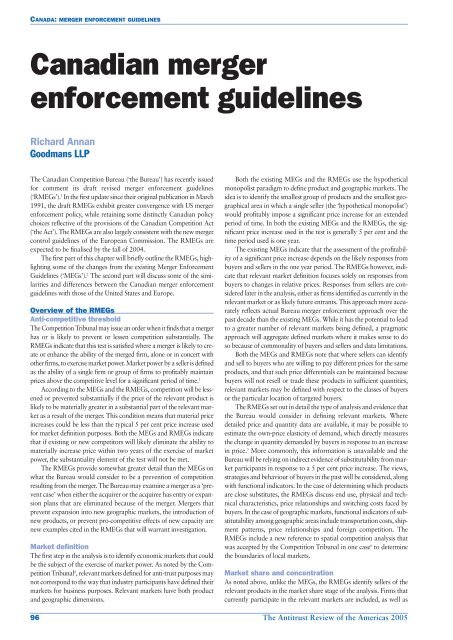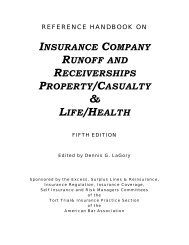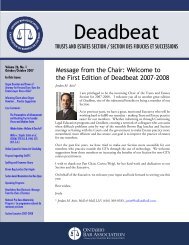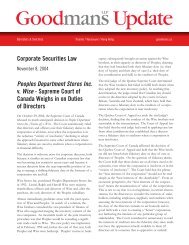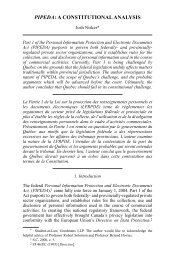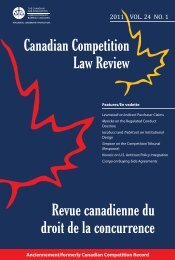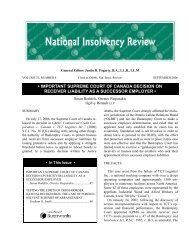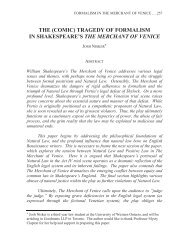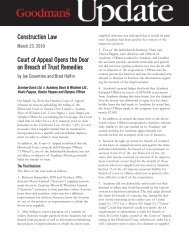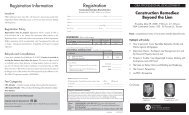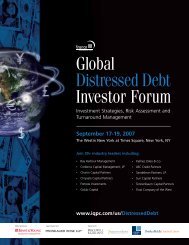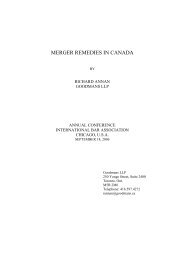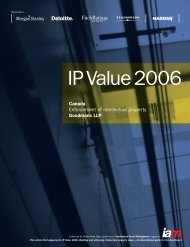Canadian merger enforcement guidelines - Goodmans
Canadian merger enforcement guidelines - Goodmans
Canadian merger enforcement guidelines - Goodmans
You also want an ePaper? Increase the reach of your titles
YUMPU automatically turns print PDFs into web optimized ePapers that Google loves.
CANADA: MERGER ENFORCEMENT GUIDELINES<br />
<strong>Canadian</strong> <strong>merger</strong><br />
<strong>enforcement</strong> <strong>guidelines</strong><br />
Richard Annan<br />
<strong>Goodmans</strong> LLP<br />
The <strong>Canadian</strong> Competition Bureau (‘the Bureau’) has recently issued<br />
for comment its draft revised <strong>merger</strong> <strong>enforcement</strong> <strong>guidelines</strong><br />
(‘RMEGs’). 1 In the first update since their original publication in March<br />
1991, the draft RMEGs exhibit greater convergence with US <strong>merger</strong><br />
<strong>enforcement</strong> policy, while retaining some distinctly <strong>Canadian</strong> policy<br />
choices reflective of the provisions of the <strong>Canadian</strong> Competition Act<br />
(‘the Act’). The RMEGs are also largely consistent with the new <strong>merger</strong><br />
control <strong>guidelines</strong> of the European Commission. The RMEGs are<br />
expected to be finalised by the fall of 2004.<br />
The first part of this chapter will briefly outline the RMEGs, highlighting<br />
some of the changes from the existing Merger Enforcement<br />
Guidelines (‘MEGs’). 2 The second part will discuss some of the similarities<br />
and differences between the <strong>Canadian</strong> <strong>merger</strong> <strong>enforcement</strong><br />
<strong>guidelines</strong> with those of the United States and Europe.<br />
Overview of the RMEGs<br />
Anti-competitive threshold<br />
The Competition Tribunal may issue an order when it finds that a <strong>merger</strong><br />
has or is likely to prevent or lessen competition substantially. The<br />
RMEGs indicate that this test is satisfied where a <strong>merger</strong> is likely to create<br />
or enhance the ability of the merged firm, alone or in concert with<br />
other firms, to exercise market power. Market power by a seller is defined<br />
as the ability of a single firm or group of firms to profitably maintain<br />
prices above the competitive level for a significant period of time. 3<br />
According to the MEGs and the RMEGs, competition will be lessened<br />
or prevented substantially if the price of the relevant product is<br />
likely to be materially greater in a substantial part of the relevant market<br />
as a result of the <strong>merger</strong>. This condition means that material price<br />
increases could be less than the typical 5 per cent price increase used<br />
for market definition purposes. Both the MEGs and RMEGs indicate<br />
that if existing or new competitors will likely eliminate the ability to<br />
materially increase price within two years of the exercise of market<br />
power, the substantiality element of the test will not be met.<br />
The RMEGs provide somewhat greater detail than the MEGs on<br />
what the Bureau would consider to be a prevention of competition<br />
resulting from the <strong>merger</strong>. The Bureau may examine a <strong>merger</strong> as a ‘prevent<br />
case’ when either the acquirer or the acquiree has entry or expansion<br />
plans that are eliminated because of the <strong>merger</strong>. Mergers that<br />
prevent expansion into new geographic markets, the introduction of<br />
new products, or prevent pro-competitive effects of new capacity are<br />
new examples cited in the RMEGs that will warrant investigation.<br />
Market definition<br />
The first step in the analysis is to identify economic markets that could<br />
be the subject of the exercise of market power. As noted by the Competition<br />
Tribunal 4 , relevant markets defined for anti-trust purposes may<br />
not correspond to the way that industry participants have defined their<br />
markets for business purposes. Relevant markets have both product<br />
and geographic dimensions.<br />
Both the existing MEGs and the RMEGs use the hypothetical<br />
monopolist paradigm to define product and geographic markets. The<br />
idea is to identify the smallest group of products and the smallest geographical<br />
area in which a single seller (the ‘hypothetical monopolist’)<br />
would profitably impose a significant price increase for an extended<br />
period of time. In both the existing MEGs and the RMEGs, the significant<br />
price increase used in the test is generally 5 per cent and the<br />
time period used is one year.<br />
The existing MEGs indicate that the assessment of the profitability<br />
of a significant price increase depends on the likely responses from<br />
buyers and sellers in the one year period. The RMEGs however, indicate<br />
that relevant market definition focuses solely on responses from<br />
buyers to changes in relative prices. Responses from sellers are considered<br />
later in the analysis, either as firms identified as currently in the<br />
relevant market or as likely future entrants. This approach more accurately<br />
reflects actual Bureau <strong>merger</strong> <strong>enforcement</strong> approach over the<br />
past decade than the existing MEGs. While it has the potential to lead<br />
to a greater number of relevant markets being defined, a pragmatic<br />
approach will aggregate defined markets where it makes sense to do<br />
so because of commonality of buyers and sellers and data limitations.<br />
Both the MEGs and RMEGs note that where sellers can identify<br />
and sell to buyers who are willing to pay different prices for the same<br />
products, and that such price differentials can be maintained because<br />
buyers will not resell or trade these products in sufficient quantities,<br />
relevant markets may be defined with respect to the classes of buyers<br />
or the particular location of targeted buyers.<br />
The RMEGs set out in detail the type of analysis and evidence that<br />
the Bureau would consider in defining relevant markets. Where<br />
detailed price and quantity data are available, it may be possible to<br />
estimate the own-price elasticity of demand, which directly measures<br />
the change in quantity demanded by buyers in response to an increase<br />
in price. 5 More commonly, this information is unavailable and the<br />
Bureau will be relying on indirect evidence of substitutability from market<br />
participants in response to a 5 per cent price increase. The views,<br />
strategies and behaviour of buyers in the past will be considered, along<br />
with functional indicators. In the case of determining which products<br />
are close substitutes, the RMEGs discuss end use, physical and technical<br />
characteristics, price relationships and switching costs faced by<br />
buyers. In the case of geographic markets, functional indicators of substitutability<br />
among geographic areas include transportation costs, shipment<br />
patterns, price relationships and foreign competition. The<br />
RMEGs include a new reference to spatial competition analysis that<br />
was accepted by the Competition Tribunal in one case 6 to determine<br />
the boundaries of local markets.<br />
Market share and concentration<br />
As noted above, unlike the MEGs, the RMEGs identify sellers of the<br />
relevant products in the market share stage of the analysis. Firms that<br />
currently participate in the relevant markets are included, as well as<br />
96 The Antitrust Review of the Americas 2005
CANADA: MERGER ENFORCEMENT GUIDELINES<br />
firms that could readily and profitably sell into the relevant market<br />
without incurring significant sunk costs. This type of supply response<br />
could occur, for example, if a firm can easily reposition a product or<br />
extend its product line to compete in the relevant product market. New<br />
entrants that incur significant sunk costs are considered in the entry<br />
part of the analysis and are not assigned a market share.<br />
Special considerations apply to foreign suppliers. The RMEGs outline<br />
a large number of factors, such as the existence of tariffs, quotas,<br />
non-tariff barriers, exchange rate fluctuations and anti-dumping<br />
actions that can impair the ability of foreign competition to participate<br />
in the relevant market.<br />
The Act makes it clear that the Competition Tribunal cannot find<br />
that a <strong>merger</strong> substantially lessens or prevents competition based solely<br />
on the evidence of market share or concentration. 7 Nevertheless, it is<br />
an important factor. The absence of high post-<strong>merger</strong> market share or<br />
concentration means that effective competition likely remains in the<br />
relevant market sufficient to defeat the exercise of market power.<br />
The Bureau will consider not only the current level of market share,<br />
but also how that market share has changed in the past and the potential<br />
for significant changes in the future due, for example, to changes<br />
in technology. The RMEGs note historical market share may be less<br />
relevant in bidding markets where rapid changes in market position<br />
are common.<br />
The RMEGs retain the safeharbour market-share thresholds set<br />
out in the MEGs. The Bureau will not generally challenge a <strong>merger</strong> on<br />
the basis of a unilateral exercise of market power where the merged<br />
firm has less than 35 per cent market share. It will not generally challenge<br />
a <strong>merger</strong> on the basis of a coordinated exercise of market power<br />
when the post-<strong>merger</strong> market share accounted by the four largest firms<br />
would be less than 65 per cent 8 or when the post-<strong>merger</strong> market share<br />
of the merged entity would be less than 10 per cent. Mergers that<br />
exceed these thresholds are not necessarily anti-competitive and the<br />
Bureau will consider the other factors set out in the Act, most notably<br />
entry conditions.<br />
Anti-competitive effects<br />
The RMEGs contain a new section outlining in detail the two types of<br />
competitive effect analysis that the Bureau undertakes: unilateral effects<br />
and coordinated effects. 9<br />
A unilateral exercise of market power occurs when the merged<br />
entity can impose a material price increase without regard to a competitive<br />
response by its rivals. This is more likely when the merging<br />
firms account for a significant share of the market, since the customers<br />
of the merged firm have limited options to turn to in response to a<br />
price increase. In markets with differentiated products, a significant<br />
price increase by the merged firm may be profitable even at a less than<br />
dominant market share if the products of the merging partners are seen<br />
as very close substitutes by customers, thereby limiting the loss of sales<br />
to other firms. In markets where firms compete based on capacity, a<br />
unilateral exercise of market power may be possible where the competing<br />
firms are capacity constrained.<br />
Coordinated effects occurs where a group of firms is able to profitably<br />
coordinate its behaviour because of each firm’s accommodating<br />
reaction to the conduct of others. The Bureau assesses whether a <strong>merger</strong><br />
makes such coordinated behaviour more likely or effective. 10 Such<br />
behaviour can involve tacit understandings on price and non-price<br />
dimensions of competition. The Bureau will consider what market conditions<br />
exist that help firms reach such understandings and that allow<br />
firms to sustain such conduct by being able to monitor one another’s<br />
conduct and credibly punish firms that deviate from the understandings.<br />
The Bureau will also consider the ability to sustain such conduct<br />
in the face of reactions by non-coordinating suppliers or buyers.<br />
The most significant change in the RMEGs compared with the<br />
MEGs is the increased emphasis and guidance given by the Bureau in<br />
its analysis of coordinated effects. This topic received little attention<br />
in the MEGs because, until recent years, the focus of the Bureau’s attention<br />
had been on determining whether a <strong>merger</strong> lessened or prevented<br />
competition based on a unilateral exercise of market power. 11<br />
In 1998 the Bureau published the Merger Enforcement Guidelines<br />
as Applied to a Bank Merger (‘BMEGs’). The BMEGs were<br />
intended to provide further guidance on the application of the MEGs<br />
to the financial services sector. They contained a more detailed explanation<br />
of coordinated effects and the factors the Bureau would consider<br />
in any such analysis. What followed was a series of cases where<br />
competition concerns were raised based in some measure on coordinated<br />
effects. 12 In the Superior Propane case, 13 the Competition Tribunal<br />
made a finding of a substantial lessening of competition in a<br />
number of markets based on an increased likelihood of interdependent<br />
(the equivalent of coordinated) behaviour.<br />
The RMEGs reflect the increased attention that the Bureau is giving<br />
to competitive concerns arising from coordinated effects. This<br />
change has generated concern among competition law practitioners in<br />
Canada. The fear is that because of its small population base, Canada<br />
has many markets that are already highly concentrated and subject to<br />
some degree of oligopolistic or coordinated behaviour. In this environment,<br />
a strict application of coordinated effects analysis could lead<br />
to very active and interventionist <strong>merger</strong> <strong>enforcement</strong>. However, the<br />
RMEGs indicate the Bureau’s analysis will consider how the <strong>merger</strong><br />
changes the competitive dynamic, for example, by removing or reducing<br />
pre-<strong>merger</strong> constraints on coordination. 14 In other words, how<br />
exactly does reducing the number of market participants by one,<br />
changing the distribution of market share or the cost structure of the<br />
merging parties increase the risk for coordinated effects? The burden<br />
of proof will rest with the Bureau to demonstrate how these changes<br />
to pre-<strong>merger</strong> conditions will likely lead to anti-competitive effects.<br />
Entry<br />
The RMEGs continue the policy choices made by the Bureau in the<br />
MEGs on its analysis of entry conditions. Emphasis in the RMEGs is<br />
placed on the timeliness, likelihood and sufficiency of entry. In order<br />
to be relevant, entry must be on a sufficient scale to defeat a material<br />
price increase in a substantial part of the relevant market within two<br />
years of the exercise of market power. In conducting this analysis, the<br />
Bureau will make an assessment of the likelihood and sufficiency of<br />
potential entry in the two year period. The analysis will consider a host<br />
of entry conditions that can impact on the decision to enter and affect<br />
the viability of any such entry, such as the presence of substantial sunk<br />
costs, the existence of long term contracts with terms that impede customer<br />
switching, changes in technology and regulatory barriers.<br />
The analysis of potential future entry or expansion by incumbents<br />
is a particularly difficult exercise. In two cases, the Bureau has been<br />
forced to amend or withdraw its application to contest a <strong>merger</strong> based<br />
on entry that occurred while the case was pending. 15<br />
Countervailing power<br />
The RMEGs contain an important new section on countervailing market<br />
power held by buyers. The RMEGs suggests that buyer concentration<br />
can prevent the exercise of seller market power if buyers can<br />
easily switch to other suppliers, can credibly expand into upstream<br />
markets or can sponsor effective new entry due to the size of business<br />
they can offer suppliers. Where price discrimination by sellers is practised<br />
in a relevant market, market power held by large buyers may be<br />
insufficient to stop the merged entity from materially increasing price<br />
to smaller buyers accounting for a significant portion of the market.<br />
Failing firm<br />
The RMEGs largely repeats the MEGs in the description of how<br />
the Bureau will treat the failing firm factor in its <strong>merger</strong> assessment.<br />
WWW.GLOBALCOMPETITIONREVIEW.COM 97
CANADA: MERGER ENFORCEMENT GUIDELINES<br />
The one notable exception is the RMEGs emphasise that the firm<br />
must be failing, that other less anti-competitive alternatives to the<br />
<strong>merger</strong> do not exist, and that in the absence of the <strong>merger</strong>, the assets<br />
of the firm will likely leave the market. In the MEGs, the failing<br />
firm factor included situations where a firm wished to exit a market<br />
for reasons other than failure, such as unsatisfactory profits.<br />
The MEGs policy choice was vulnerable to strategic utilisation by<br />
<strong>merger</strong> proponents and it was very difficult to objectively verify<br />
whether in fact the assets would leave the market in the absence of<br />
the proposed transaction.<br />
Efficiency exception<br />
Canada is one of the few jurisdictions in the world that contain an<br />
explicit legislated trade-off between anti-competitive effects and efficiency<br />
gains. Considerable controversy has surrounded the application<br />
of this provision in Canada, raising fundamental questions about<br />
the objectives of the Competition Act.<br />
In the MEGs, the Bureau adopted a total surplus approach where<br />
the only anti-competitive effects that are taken into account in the<br />
trade-off are those losses in surplus that result from a reduction in output,<br />
referred to by economists as the ‘deadweight’ loss. Under this<br />
approach, wealth transfers from buyers to sellers when prices are<br />
increased are ignored because they do not represent losses to the economy<br />
as a whole. This approach assumes that allocative efficiency is<br />
the paramount objective of the Act.<br />
In the Superior Propane case, the Bureau advanced a different standard<br />
that would include a broader range of anti-competitive effects,<br />
including some portion of the wealth transfers from buyers to sellers.<br />
The Competition Tribunal in that case ultimately adopted a standard<br />
that encompassed the deadweight loss and the “socially adverse” portion<br />
of the transfer. This approach requires the Bureau to assess the<br />
socio-economic profiles of buyers and sellers to determine what value<br />
each places on income.<br />
The Bureau has stated that in light of the Superior Propane<br />
jurisprudence, it supports a change in the efficiency standard to provide<br />
a more workable approach that recognizes all of the objectives of<br />
the Act, including consumer interests. 16 In the interim, the RMEGs<br />
indicate that the Bureau will consider a broader range of anti-competitive<br />
effects than the deadweight loss when performing the tradeoff<br />
analysis. These effects will include redistributive effects, non-price<br />
effects in the reduction of service, quality and choice, losses of productive<br />
efficiency 17 and losses of dynamic efficiency. On the other side<br />
of the trade-off, the Bureau will also consider gains in productive and<br />
dynamic efficiency that may result from the <strong>merger</strong>.<br />
Comparison to US <strong>merger</strong> <strong>enforcement</strong> policy<br />
The analytical approach outlined in the RMEGs will be instantly familiar<br />
to readers of the Horizontal Merger Guidelines of the US Department<br />
of Justice and the Federal Trade Commission (‘US HMGs’). The<br />
two <strong>guidelines</strong> share far more similarities than differences.<br />
The original MEGs are already similar in approach to the US<br />
HMGs. Both use the hypothetical monopolist paradigm for market<br />
definition, both call for an extensive entry analysis and both outline<br />
many common analytical factors.<br />
The RMEGs strengthen that convergence by providing greater<br />
detail and emphasis on coordinated effects, more detail on unilateral<br />
effects and by moving supply side substitution from market definition<br />
to the market share part of the analysis. The organization of the<br />
RMEGs also more closely resembles the US HMGs by integrating the<br />
various factors to be considered under s.93 18 of the Act into categories<br />
of competitive effects and entry conditions.<br />
Nevertheless, differences arise because of distinct governing legislation,<br />
jurisprudence and <strong>enforcement</strong> policy choices. In relation to<br />
concentration, the <strong>Canadian</strong> safeharbour thresholds are based on mar-<br />
ket share and CR4, not the Herfindahl-Hirschman Index (‘HHI’) set<br />
out in the US HMGs. The RMEGs allow a material price increase to<br />
persist for up to two years before it is found to be substantial. While<br />
this concept is not included in the US HMGs, it is the case in the US<br />
that committed entry that is likely to occur, and that would be sufficient<br />
to counteract the competitive concerns, will be considered if it<br />
happens within two years.<br />
In terms of entry, the US HMGs indicate that “entry that is sufficient<br />
to counteract the competitive effects of concern will cause prices<br />
to fall to their pre<strong>merger</strong> levels or lower”. 19 There is no requirement<br />
in the RMEGs that entry must drive prices to the pre-<strong>merger</strong> level, only<br />
that they eliminate a material price increase. This is consistent with<br />
<strong>Canadian</strong> jurisprudence which indicates that <strong>merger</strong> remedies do not<br />
have to return the market to a pre-<strong>merger</strong> level of competition, only<br />
that they reduce any lessening or prevention of competition below the<br />
“substantial” threshold. 20<br />
Efficiencies, in the US, must be large enough to reverse the potential<br />
harm to consumers caused by the <strong>merger</strong> in the relevant market,<br />
for example by preventing price increases to consumers. There is no<br />
such consumer welfare requirement in the RMEGs.<br />
Comparison to European <strong>merger</strong> <strong>enforcement</strong> <strong>guidelines</strong><br />
The European guidance on <strong>merger</strong> <strong>enforcement</strong> is contained in two<br />
documents, one related to market definition 21 for <strong>merger</strong> and non<strong>merger</strong><br />
provisions, and another guideline on issues specific to <strong>merger</strong><br />
review 22 (collectively, ‘EU MEGs’).<br />
In terms of market definition, the EU MEGs appear to adopt a<br />
hypothetical monopolist approach since they posit a small non-transitory<br />
price increase of 5 per cent to 10 per cent and examine the<br />
degree of buyer substitution in response. However, the analysis is not<br />
limited to demand substitution but can include supply substitution<br />
at the market definition stage, if it has the same degree of immediacy<br />
and effectiveness as demand substitution. This is consistent with<br />
the current MEGs approach that includes supply responses that<br />
occur within one year in the market definition analysis, although<br />
inconsistent with the RMEGs and US HMG approach of including<br />
this type of supply response in the market share analysis after the<br />
market has been defined.<br />
In relation to market share and concentration, the EU MEGs utilise<br />
a blended approach of the HHI and market share to delineate safeharbours.<br />
One safeharbour indicates that if the merged firm has a combined<br />
market share of less than 25 per cent, it would generally not be<br />
problematic. The equivalent <strong>Canadian</strong> safeharbour of 35 per cent is<br />
somewhat more permissive that the EU standard. There is no <strong>Canadian</strong><br />
safeharbour based on the HHI.<br />
The EU MEGs have an extensive discussion of unilateral<br />
(referred to as “non-coordinating”) effects and coordinated effects<br />
as the two main categories of competitive harm. This discussion is<br />
very similar to that contained in the US and <strong>Canadian</strong> <strong>guidelines</strong>,<br />
and in fact is more extensive in providing guidance on coordinated<br />
effects than the RMEGs. Particular mention is made of joint ventures<br />
and cross-shareholdings in the EU MEGs in relation to the<br />
potential for coordinating effects.<br />
The entry analysis is consistent with the US and <strong>Canadian</strong> requirements<br />
of likelihood, timeliness and sufficiency. Entry normally should<br />
occur within two years. It must be sufficiently profitable taking into<br />
account the additional output of that entry into the market.<br />
Like the RMEGs, the EU MEGs contain a section on countervailing<br />
buyer power, although no discussion of this concept is found<br />
in the US HMGS.<br />
Finally, in relation to efficiencies, the EU MEGs require that consumers<br />
be no worse off as a result of the <strong>merger</strong>. Efficiencies must be<br />
timely and passed on to produce benefits to consumers. This consumer<br />
welfare approach is clearly not the law in Canada at this time.<br />
98 The Antitrust Review of the Americas 2005
CANADA: MERGER ENFORCEMENT GUIDELINES<br />
Conclusion<br />
The RMEGs effectively update the MEGs by incorporating the<br />
jurisprudence, new economic thinking and changes in <strong>enforcement</strong><br />
approaches that have occurred in the 13 years since their original publication.<br />
They have achieved even greater convergence with the <strong>guidelines</strong><br />
of Canada’s major trading partners, the United States and Europe.<br />
Greater <strong>enforcement</strong> convergence should improve the efficiency of<br />
cross-border <strong>merger</strong> review, reduce the potential for conflicting decisions<br />
and lower compliance costs.<br />
Notes<br />
1 Merger Enforcement Guidelines, Draft for Consultation”, Competition<br />
Bureau, March 2004 (RMEGs)<br />
2 “Merger Enforcement Guidelines” Director of Investigation and Research<br />
Competition Act, Information Bulletin No. 5, March 1991 (MEGs)<br />
3 A parallel analysis follows in the case of market power held by buyers, who<br />
would have the ability to depress prices and hence output below<br />
competitive levels for a significant period of time.<br />
4 Canada (Commissioner of Competition) v Superior Propane Inc CT-<br />
1998/002 2000 (Competition Tribunal) 30 August 2000 para.85, 101<br />
5 The Competition Tribunal in Superior Propane indicated that the own-price<br />
elasticity of demand was the measure to be used for market definition,<br />
while cross-price elasticity of demand was a useful but indirect measure<br />
of substitutability. (ibid at para 62) Own-price elasticity measures the<br />
percentage change in quantity demanded for a given percentage change<br />
in price for a product, while cross-price elasticity measures the percentage<br />
change in quantity demanded of one good for a given percentage change<br />
in price in another good.<br />
6 Superior Propane, at para 106. For an explanation of spatial analysis, see<br />
Superior Propane at para 87-90. In Commissioner of Competition v<br />
<strong>Canadian</strong> Waste Services Holdings Inc (CT file 2000/002 Decision dated<br />
March 28/01, para.76-83), the Competition Tribunal discusses the spatial<br />
analysis of the Commissioner’s expert.<br />
7 Section 92(2) of the Competition Act<br />
8 Economists refer to this concentration measure as the CR4 ratio.<br />
9 In the MEGs, the term interdependent behaviour is used to describe the<br />
type of conduct covered by coordinated effects as described in the<br />
RMEGs.<br />
10 RMEGs, Para 5.17<br />
11 The one notable exception was the acquisition of <strong>Canadian</strong> operations of<br />
Texaco by Imperial Oil. This transaction raised significant competition<br />
concerns based largely on coordinated effects. Canada (Director of<br />
Investigation and Research) v Imperial Oil Limited (unreported, 6 February<br />
1990, Competition Tribunal, file CT89/3).<br />
12 In 1998 the Bureau concluded that the proposed <strong>merger</strong> of the Royal<br />
Bank of Canada and the Bank of Montreal and the <strong>merger</strong> of the <strong>Canadian</strong><br />
Imperial Bank of Commerce with the Toronto-Dominion Bank would<br />
substantially lessen or prevent competition. This conclusion took into<br />
account an increased likelihood of coordinated behaviour following the<br />
<strong>merger</strong>s. In Abitibi’s acquisition of Donohue, coordinated effects played<br />
an important role (Statement of Grounds and Material Facts,<br />
Commissioner of Competition v Abitibi-Consolidated Inc unreported 22<br />
Jan.2002 Competition Tribunal file no. CT01/9), as well as in Bayer’s<br />
acquisition of Aventis (Statement of Grounds and Material Facts, The<br />
Commissioner of Competition v Bayer AG and Aventis CropScience Holding<br />
SA (unreported) 31 May 2002, Competition Tribunal, file no.CT02/3).<br />
13 Superior Propane, at Para. 308-309<br />
14 RMEGs, Para 5.23<br />
15 Director of Investigation and Research v <strong>Canadian</strong> Pacific Limited<br />
Competition Tribunal CT-1996/002, Director of Investigation and<br />
Research v Dennis Washington et al (1996) unreported Competition<br />
Tribunal CT-1996/001<br />
16 “Bill C249 An Act to Amend the Competition Act Speaking Notes for<br />
Sheridan Scott, Commissioner of Competition”, before the Standing<br />
Senate Committee on Banking, Trade and Commerce, 12 May 2004<br />
17 The idea is that some <strong>merger</strong>s creating monopolies or near monopolies<br />
may increase costs since the incentive to be cost competitive is less if the<br />
merged firm is insulated from competitive pressure.<br />
18 Factors to be considered regarding the substantial prevention or lessening<br />
of competition.<br />
19 HMG, section 3.0<br />
20 Canada (Director of Investigation and Research v Southam [1997] 1<br />
S.C.R. 748 para. 85<br />
21 Commission Notice on the definition of the relevant market for the<br />
purposes of Community competition law, Official Journal of the European<br />
Union OJ C372 on 9 December1997<br />
22 Guidelines on the assessment of horizontal <strong>merger</strong>s under the Council<br />
Regulation on the control of concentrations between undertakings, Official<br />
Journal of the European Union 5 February 2004, C31/5-C31/18<br />
2400-250 YONGE STREET<br />
TORONTO, ONTARIO CANADA M5B 2M6<br />
TEL: +1 416 979 2211<br />
FAX: +1 416 979 1234<br />
CONTACTS:<br />
RICHARD ANNAN<br />
TEL: +1 416 597 4272<br />
RANNAN@GOODMANS.CA<br />
WILLIAM P. ROSENFELD<br />
TEL: +1 416 597 4145<br />
WROSENFELD@GOODMANS.CA<br />
DANIEL GORMLEY<br />
TEL: +1 416 597 4111<br />
DGORMLEY@GOODMANS.CA<br />
WWW.GOODMANS.CA<br />
<strong>Goodmans</strong> LLP is recognised internationally as one of Canada’s premier transaction law firms.<br />
Founded in 1917, <strong>Goodmans</strong> is based in Toronto and has offices in Vancouver and Hong Kong.<br />
With over 190 lawyers, <strong>Goodmans</strong> acts as counsel to a broad range of <strong>Canadian</strong>, US and foreign<br />
enterprises, from sole proprietorships to multi-national corporations, banks and governments<br />
across virtually every sector of the economy. <strong>Goodmans</strong> offers a full range of services<br />
and expertise in all major areas of business law.<br />
<strong>Goodmans</strong>’ competition law group is recognised for its ability to work seamlessly and effectively<br />
with the firm’s number one ranked M&A practice—often advising on the largest and most<br />
complex deals in Canada. <strong>Goodmans</strong> has extensive industry-specific expertise in financial services,<br />
manufacturing, telecommunications, airlines, entertainment, broadcasting, newspaper<br />
publishing, forestry, pulp and paper and mining sectors. This expertise enables us to identify<br />
and resolve competition law issues in order to ‘get the deal done’.<br />
In addition to <strong>merger</strong> review, the firm regularly advises clients in contentious matters that raise<br />
competition issues relating to the criminal and civil provisions of the Competition Act, including<br />
conspiracy, abuse of dominance, resale price maintenance, refusal to deal and deceptive<br />
marketing practices.<br />
WWW.GLOBALCOMPETITIONREVIEW.COM 99


